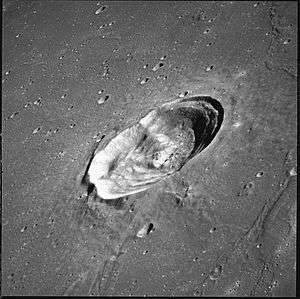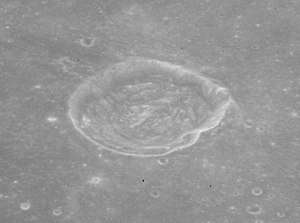Arago (lunar crater)
.png) | |
| Coordinates | 6°12′N 21°24′E / 6.2°N 21.4°ECoordinates: 6°12′N 21°24′E / 6.2°N 21.4°E |
|---|---|
| Diameter | 26 km |
| Depth | 1.8 km |
| Colongitude | 358° at sunrise |
| Eponym | François Arago |


Arago is a lunar impact crater located in the western part of the Mare Tranquillitatis which is named after François Arago.[1] Nearly 45 km southwest lies the crater Manners, and beyond are Dionysius and the Ritter–Sabine crater pair. To the southeast is the large Lamont formation that has been submerged by the mare.
Its diameter is 26 km long and is 1,800 meters deep. The area is about 500 km² and the perimeter is over 75 km.
From that location the Earth would appear in the lunar sky at over 6 degrees from the top and it is seen more than 21 degrees towards the west, sometimes due to librations, it appears about 7 degrees in different directions.
The rim of Arago has a bulge in the western wall. There is a central ridge that runs towards the northern wall. The surface of the mare nearby is marked by wrinkle ridges, most notably to the east and southeast. To the north is a large lunar dome designated Arago Alpha (α). A similar-sized lunar dome is located an equal distance to the west, designated Arago Beta (β).
Satellite craters
By convention these features are identified on lunar maps by placing the letter on the side of the crater midpoint that is closest to Arago.
| Arago[1] | Coordinates | Diameter, km |
|---|---|---|
| B | 3°26′N 20°49′E / 3.43°N 20.82°E | 6,9 |
| C | 3°53′N 21°29′E / 3.89°N 21.48°E | 3,0 |
| D | 6°55′N 22°23′E / 6.91°N 22.39°E | 4,0 |
| E | 8°31′N 22°43′E / 8.51°N 22.71°E | 6,3 |
See also
Notes
- 1 2 "Arago (lunar crater)". Gazetteer of Planetary Nomenclature. USGS Astrogeology Research Program.
References
- Andersson, L. E.; Whitaker, E. A. (1982). NASA Catalogue of Lunar Nomenclature. NASA RP-1097.
- Blue, Jennifer (July 25, 2007). "Gazetteer of Planetary Nomenclature". USGS. Retrieved 2014-11-19.
- Bussey, B.; Spudis, P. (2004). The Clementine Atlas of the Moon. New York: Cambridge University Press. ISBN 978-0-521-81528-4.
- Cocks, Elijah E.; Cocks, Josiah C. (1995). Who's Who on the Moon: A Biographical Dictionary of Lunar Nomenclature. Tudor Publishers. ISBN 978-0-936389-27-1.
- McDowell, Jonathan (July 15, 2007). "Lunar Nomenclature". Jonathan's Space Report. Retrieved 2007-10-24.
- Menzel, D. H.; Minnaert, M.; Levin, B.; Dollfus, A.; Bell, B. (1971). "Report on Lunar Nomenclature by the Working Group of Commission 17 of the IAU". Space Science Reviews. 12 (2): 136–186. Bibcode:1971SSRv...12..136M. doi:10.1007/BF00171763.
- Moore, Patrick (2001). On the Moon. Sterling Publishing Co. ISBN 978-0-304-35469-6.
- Price, Fred W. (1988). The Moon Observer's Handbook. Cambridge University Press. ISBN 978-0-521-33500-3.
- Rükl, Antonín (1990). Atlas of the Moon. Kalmbach Books. ISBN 978-0-913135-17-4.
- Webb, Rev. T. W. (1962). Celestial Objects for Common Telescopes (6th revised ed.). Dover. ISBN 978-0-486-20917-3.
- Whitaker, Ewen A. (1999). Mapping and Naming the Moon. Cambridge University Press. ISBN 978-0-521-62248-6.
- Wlasuk, Peter T. (2000). Observing the Moon. Springer. ISBN 978-1-85233-193-1.
External links
| Wikimedia Commons has media related to Arago (lunar crater). |
Other articles
- Wood, Chuck (June 14, 2007). "Something for Everyone". Lunar Photo of the Day. Archived from the original on November 18, 2017.
- Wood, Chuck (December 8, 2009). "Edgy". Lunar Photo of the Day.
